August 17 - 23, 2014: Issue 176
Albert Thomas Black
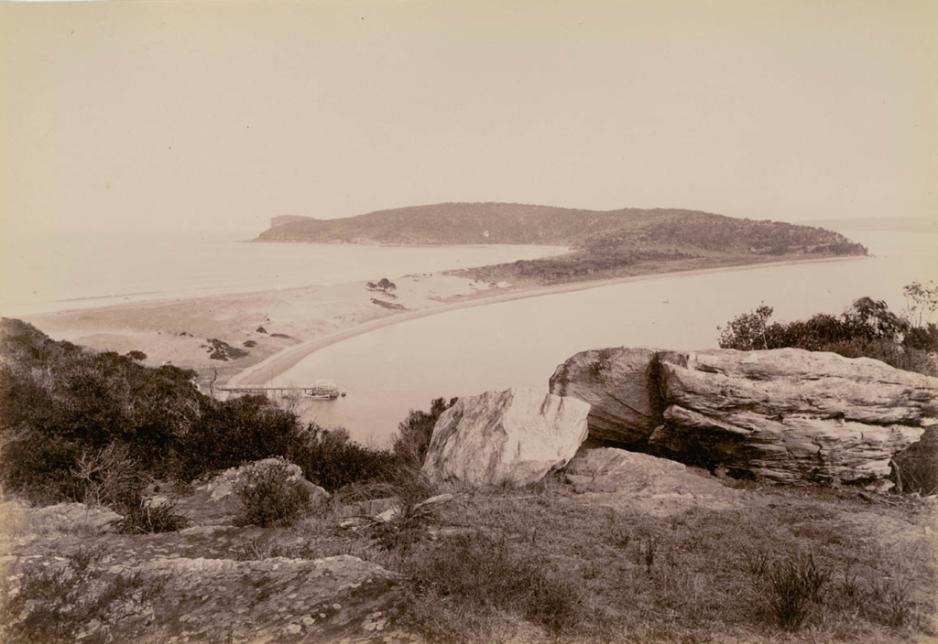
South Head, Barrenjoey, 'Hawkesbury River' - circa 1900, Image No.: a116420, courtesy State Library of NSW.
Albert Thomas Black
15th May, 1840 – 22nd August, 1890
Albert Thomas Black was the third son and sixth child of John Henry Black, also born in May on the 31st, 1799 in the fledgling colony of NSW, to Mary Hyde and John Black.
John Black, born on 31 Oct 1778 in Great Yarmouth, Norfolk, England, the eldest son of Scottish parents the Reverend John Black (1753–1813) and May Logie (1747-?). He was christened on 29 Nov 1778, and died in 1802/1803 at sea aboard the Fly:
The Castle of Good Hope is the largest ship that has ever entered this port, and measures about 1000 tons. During the passage she lost 12 cows and 1 horse ; fell in with no other vessel, and met with no accident. Her passing through Bass's Straits instead of going round Van-Dieman's Land, considerably shortened her passage, and saved many cows. By the above arrival we have been informed of the more than probable loss of the Fly, a vessel of about 100 tons burthen, laden with piece and other valuable goods, also bound for this place, and belonging to the House of CAMPBELLS, at Calcutta. She left Calcutta in the month of April last, and has not since been heard of; was commanded by Mr. JOHN BLACK, a young man much esteemed here by all who knew him. SHIP NEWS. (1803, March 5). The Sydney Gazette and New South Wales Advertiser (NSW : 1803 - 1842), p. 2. Retrieved from http://nla.gov.au/nla.news-article625433
John Black, descendant of Captain John Black on his relative:
My original ancestor came out here in 1798 … (Captain John Black) I’ve read a lot from him as he wrote letters back to his father. He speaks a lot of the experiences and adventures he had on one voyage. He embarked on a convict ship called the ‘Lady Shore’ which left England in 1797, he was only 19. They had a cargo of female convicts on board and were guarded by a platoon of British Marines. Off the coast of Brazil the Marines mutinied, killed the Captain and took over the ship, and they put the officers and passengers in a longboat and my ancestor at the age of 19, then sailed this longboat to the coast of Brazil and successfully got ashore despite the mutineers expecting them to be lost at sea. He then had various adventure travelling along the coast of Brazil, and ended up at St Catherine island where he shipped aboard another vessel called The ‘Indispensable’ which had letters of marque and was out hunting Spanish ships. Britain was at war with Spain at the time.
They captured a Spanish ship (La Union)and he was the only other person who could navigate so he was put in charge of that ship and it was then sold and with the proceeds from that he then invested in Port Jackson, sailing out here and establishing himself here.
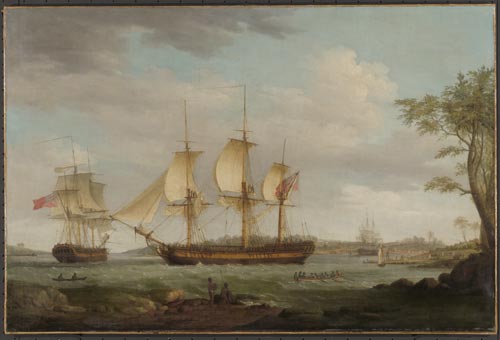 John married Mary Hyde, daughter of Edward Hyde and Sarah Blunn, in 1799 in Sydney, NSW, Australia. Marriage status: common law. Mary was born in February 1778 in Halesowen, Worcestershire, England, and was christened on 19 Feb 1779. She had been transported as a 17 year old for stealing from her employer '1 black silk cloak, 1 muslin shawl, 1 cotton gown, 1 dimity petticoat, 2 pair of cotton stockings and 1 pair of scissors'.
John married Mary Hyde, daughter of Edward Hyde and Sarah Blunn, in 1799 in Sydney, NSW, Australia. Marriage status: common law. Mary was born in February 1778 in Halesowen, Worcestershire, England, and was christened on 19 Feb 1779. She had been transported as a 17 year old for stealing from her employer '1 black silk cloak, 1 muslin shawl, 1 cotton gown, 1 dimity petticoat, 2 pair of cotton stockings and 1 pair of scissors'.
Right: Britannia, shown here leaving Sydney Cove, courtesy National Library of Australia, Reference: nla.pic-an2253068, Oil painting by Thomas Whitcombe
Mary arrived in Sydney aboard the whaling ship Britannia II on the 18th of July, 1798 with 94 other female convicts.
The couple had John Henry (1799) and his sister Mary Ann (1801) - their mother left alone to raise these babies while her husband was at sea. In March 1799 Governor Hunter granted a lease of land to “Mr. John Black, late purser of the Lady Shore transport”. This allotment is shown on surveyor James Meehan’s map of Sydney on the eastern side of George Street, between Hunter Street and Martin Place, where De Mestre Place is today. This land was later held in trust for John Black’s two children, and became the land on which Black’s son-in-law Prosper de Mestre resided and ran his business from. While Captain Black was at sea Mary Hyde resided on this allotment backing onto the Tank Stream.
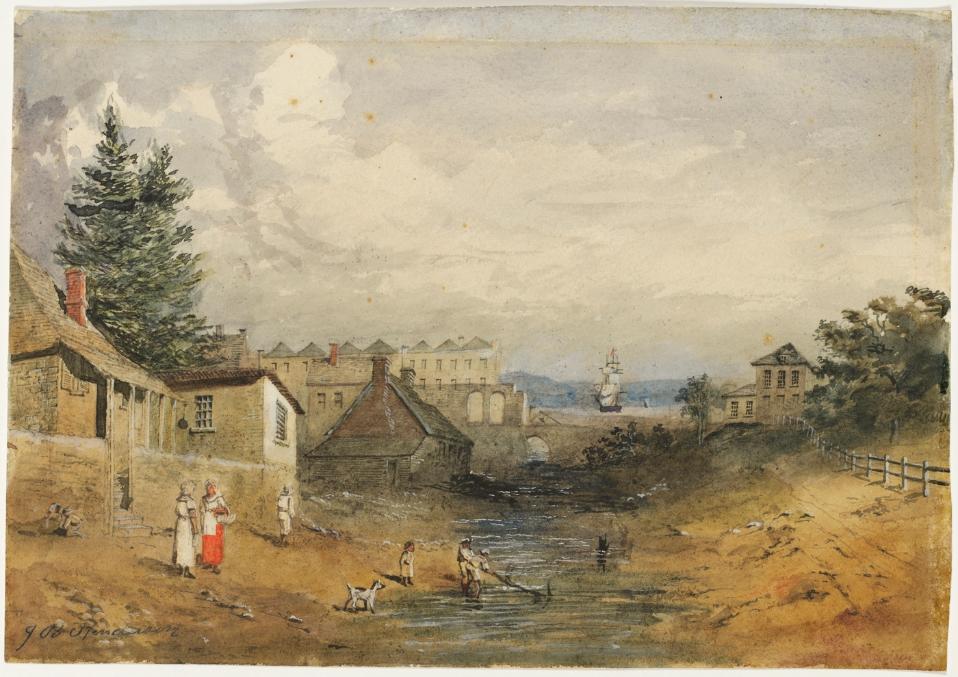
Old Tank Stream Sydney, 1852? / by John Black Henderson Item a1528052. Courtesy State Library of NSW
Black's family was fending for itself whilst John was often away for months at a time, or even longer, either whaling or otherwise working his trade as a ship's officer.
Captain John Black was a notable sailor of this time and his voyages on the Indispensable after John Henry's christening on September 2nd, 1799, included:
....sailed back to Cape Town from Sydney in what was then regarded as the shortest passage (time-wise). It was a long tedious voyage up the east coast of Australia, above New Guinea, and through the islands of Indonesia using the more favourable winds of the south-east monsoon (as compared to the adverse strong westerlies along the southern coast of Australia) before sailing upwind or beating across the Indian Ocean down to Cape Town.
After arriving in Cape Town some months later, John Black became engaged in adventure that continued to keep him away from his family. The Englishman was engaged for the first time as a Captain on the privateer Chance owned by Michael Hogan. As Spain was then at war with England Black was engaged to sail from Cape Town seeking Spanish ships. His mission was successful as on 8 July 1800 a Spanish Brig of 70 tons arrived in Cape Town carrying prize colours.
After taking his share of the spoils from the sale of the Spanish Brig and its cargo, Black took command of the brig Harbinger also owned by Michael Hogan. Carrying a cargo of 2,800 gallons of spirits and 3,000 gallons of wine, in November 1800 Black began to sail back to Sydney, and his family.
As an aside, in 1800 it was recorded that ‘’Mary Hide(sic) and her son were off the’’ (government) ‘’stores’’. This was because Mary "living on the lease of Mr. Black; and owing 7 sheep, 4 pigs and 3 goats’’ had been able to meet a level of self-sufficiency, something the government greatly encouraged in an effort to cut costs.
Heading east across the Indian Ocean for Sydney, with instructions to take the short cut through the newly discovered Bass Strait (which separated Australia from Tasmania), he followed in the wake of the brig Lady Nelson, the first ship to sail eastward through the new-found Bass Strait. The Harbinger embarked on an investigation of the strait tracking around Cape Otway, Cape Danger and Cape Patten down to the northern part of King Island, and around Wilsons Promontory. He had sheltered near two small islands whichhe named the New Year Isles, and then sailed on and named the larger island King Island after Governor Philip Gidley King.He also named the Harbinger Rocks, and sighted the Hogan group of islands. A chart drawn later by Governor King shows John Black's course through Bass Strait. Governor King's report on the voyage reads: "A small brig from the Cape of Good Hope, commanded by Mr. Black (a person of good abilities as a surveyor and navigator) passed thro and keeping more to the Southward made Cape Albany Otway and standing to the southward made an island lying in the centre of the west entrance of the strait which he named King Island and afterwards passed thro the centre of the strait unadvisable to attempt from the east only from the west." A copy of Blacks writing on the passage through Bass Strait in the Harbinger was sent to England with Governor King's letter.
Black arrived back in Sydney on 11 January 1801 after having been away for 14 months, at which time his partner Mary Hyde promptly became pregnant with their second child. This was the beginning of his longest time in port and with his family, and lasted nearly 12 months. Mary Ann was born on October 1st, 1801.
Black discharged his cargo of rum and wines in Sydney into the warehouse that the businessman Simeon Lord had built specifically for this purpose. (Coincidentally Simeon Lord was later to be the step-father to Black’s children.) In selling his cargo Black had entered Sydney’s liquor trade, and established a shop on his leased land. It was reported "Simeon Lord sells rum at 32/- a gallon, Capt. Cox ditto, Black his gin at 10 gns”(guineas) “a case, etc. these are Governor King’s regulations for the benefit of the Colony while American ships who would be glad to sell their liquor at 5/-, 6/- or 7/- per G.”(gallon) “are turned away! Why!"
Black also he negotiated with Governor King to sell him the Harbinger on behalf of its owner. On 1 May 1801 the Governor wrote to the Duke of Portland, stressing the old age of vessels used by the Government and the need for replacements. “The Master of the brig Harbinger, recently arrived from the Cape, has offered her for sale. As a vessel is needed to go between Norfolk Island to carry supplies and bring salt port from thence, I directed a survey to be taken of that vessel, also an inventory of her masts, rigging and furniture. The sum demanded by the owner was 1500 pounds and the offer I made him was 700 pounds, though much less than her real value.” Because of money shortage in Sydney, there was no other bidder for the Harbinger, so Black was compelled to accept the Governor's 700 pounds.
The documents relating to the sale of the Harbinger were signed by John Black in June 1801 where he described himself as a resident of Sydney, and receipted by him on 3 August 1801.
On 7 September 1801 Governor Philip Gidley King granted Black's partner Mary Hyde an Absolute Pardon 18 months before her sentence would have expired. From the wording of the pardon, it would appear that John Black used his credit with the Governor King to obtain this Absolute Pardon for his partner. (1.)
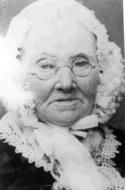 After the loss of her common law husband at sea Mary began a relationship in around 1805 with Simeon Lord, also a former convict and business associate of John Black. He adopted both her children and they went on to have eight together. The family also comprised a girl, Joanna Short, the orphan of two convicts Elizabeth Drudra and Joseph Short, whom Lord had adopted when she was less then four years old - she was nearly a teenager by 1805 though. Mr. Lord became a very successful businessman and between the two of them they became the two of the largest land holders in the colony at that time.
After the loss of her common law husband at sea Mary began a relationship in around 1805 with Simeon Lord, also a former convict and business associate of John Black. He adopted both her children and they went on to have eight together. The family also comprised a girl, Joanna Short, the orphan of two convicts Elizabeth Drudra and Joseph Short, whom Lord had adopted when she was less then four years old - she was nearly a teenager by 1805 though. Mr. Lord became a very successful businessman and between the two of them they became the two of the largest land holders in the colony at that time.
John Henry Black was working at the ten year old Bank of New South Wales when he married Louisa Skinner, daughter of Mary Watkins and Samuel Skinner:
MARRIED, Yesterday morning, by Special License, by the Rev. RICHARD HILL, in St. James' Church, Mr. JOHN BLACK, Principal Accountant of the Bank of New South Wales, to Miss LOUISA SKINNER. Family Notices. (1827, June 15). The Sydney Gazette and New South Wales Advertiser (NSW : 1803 - 1842), p. 2. Retrieved from http://nla.gov.au/nla.news-article2188424
Louisa and John Henry Black had eight children; Mary Ann, Louisa Maria, John Andrew, Sarah Theresa (Sally), Edward Simeon, Albert Thomas, Reginald James and Sydney Augustus. Tragically two of these were lost to illness when Albert was a mere six years old:
On the 23rd instant, at the residence of his father, after a short but painful illness, Edward Simeon, the second son of John Henry BLACK, of the Bank of New South Wales, aged nine years. Family Notices. (1846, September 24). The Sydney Morning Herald (NSW : 1842 - 1954), p. 3. Retrieved from http://nla.gov.au/nla.news-article12895584
BLACK, Louisa Maria, second daughter of John Henry Black, of the Bank of New South Wales, after a long and severe illness, aged fifteen years and nine months, on the 11th Instant. Family Notices. (1846, October 13). The Australian (Sydney, NSW : 1824 - 1848), p. 2. Retrieved from http://nla.gov.au/nla.news-article37154879
Obituary. We regret to announce the decease of Miss Louisa Maria BLACK, second daughter of the respected Cashier of the Bank of New South Wales, John Black, Esq. The late lamented young lady died on Sunday, the 11th instant, after a painful and protracted illness, following to the grave, with a heart-rending fatality, a younger brother who expired suddenly at the residence of his father, but a few days previous. If the sympathy of sincerity can avail anything in ameliorating the agonising distresses of such parental affliction, Mr. and Mrs. Black's cup of misery will most certainly be deprived of its bitterest dregs. The mortal remains of the lamented lady were conveyed to their last sad resting-place on Wednesday morning last. Family Notices. (1846, October 17). Bell’s Life in Sydney and Sporting Reviewer(NSW : 1845 - 1860), p. 3. Retrieved from http://nla.gov.au/nla.news-article59765397
J H Black followed in his mother's footsteps in acquiring land:
THE Commissioners for hearing and determining upon Claims to Grains of Land within the Colony of New South Wales, under the Act of the Government and Council 4th Wm. IV., No. 3, do hereby give Notice, that the following claims have been filed with the Secretary. To wit:
No. 456. By John Henry Black, gentleman, George street, Sydney, to 48 rods of land, leased by Sir Thomas Brisbane to James Foster, described as follows: situate on the west side of Castlereagh -steet, in the township of Sydney, parish of St. James, and comity of Cumberland, bounded on the south by a line 299 links, on the west by a line 105 links, on the north by a line to the street 299 links, mid on the east by a line to Castlereagh –street 1 chain.
No. 457. By John Henry Black, gentleman, Sydney, to 48 rods of land, leased by Governor Macquarie to Mary Skinner, deceased, described as follows :situate on the west side of Pitt-street, 111 the township of Sydney, parish of St. James, bounded on the east by I'm street south 4 ½ degrees east 68 feet from Barnes' comer, on the south by a line west 4½ degrees south 147 feet to the stream of the Tanks, on the west by n line 6 ½ degrees west 82 feet, and on the north by Barnes's lease.
No. 472. By John Henry Black, George-street, Sydney, to 49 rods of land, leased by Sir Thomas Brisbane to McDermott, described as follows : situate ontile west side of Castlereagh -street, in the township of Sydney, parish of St. James, and county of Cumberland, bounded on the south by a line 344 links, on the west by 11 line 9o links, on south by a line to Castlereagh – street 344 links, and on the east by that street 90 links. CLAIMS TO LAND. Register No. 1. (1834, June 2). The Sydney Herald (NSW : 1831 - 1842), p. 4. Retrieved from http://nla.gov.au/nla.news-article12849490
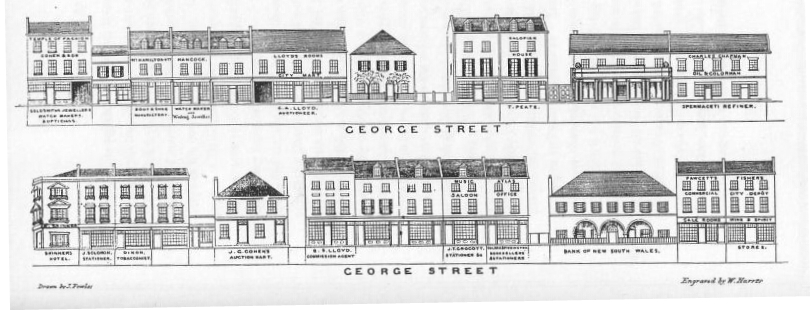
BIRTH. At the Bank of New South Wales, on the 15th instant, Mrs BLACK, of a son. Family Notices. (1840, May 16). The Australian (Sydney, NSW : 1824 - 1848), p. 2. Retrieved from http://nla.gov.au/nla.news-article36861220
BIRTH. At the Bank of New South Wales, on the 15th instant, the lady of John BLACK, Esq., of a son. Family Notices. (1840, May 18).The Sydney Monitor and Commercial Advertiser (NSW : 1838 - 1841), p. 5 Edition: MORNING. Retrieved from http://nla.gov.au/nla.news-article32183252
The range and amount of Customs Import Entries listed beside 'A. Black' from the early 1860's on, and taking into account that his father had managed Simeon Lord's hat manufacturing business in 1815 at Botany, a younger Albert may have had his taste for the salt air life engendered through access to the harbour and Botany in his early years, a knowledge of Customs Law through his grandmother's tending to her husband's business (who passed away in 1864, Simeon Lord predeceasing her in 1840), all the components for becoming the Broken Bay Customs Station Coast Waiter were developing.
Jervis Sparks, in his excellent Tales from Barranjoey (1992), also cites Francis Hixson's marriage in 1861 to Sarah (daughter of Francis Lord, second son and fourth child of Simeon and Mary) as a boon. Hixson was appointed superintendent of pilots, lighthouses and harbours in New South Wales in 1863.
Albert Thomas Black was appointed to Broken Bay Customs Station on October 1st, 1868, an event preceded by his marriage to a beautiful teenager:
MARRIAGES. On the 21st March, by the Rev. Dr. Fullerton, ALBERT THOMAS BLACK, to KATE MARGARET, second daughter of the late Mr. JOHN MULLIGAN. Family Notices. (1868, May 5). The Sydney Morning Herald(NSW : 1842 - 1954), p. 1. Retrieved fromhttp://nla.gov.au/nla.news-article13165589
Notice of his appointment misspells his name:
Mr. Alexander T. Black, to be Customs' Coast Waiter at Broken Bay, vice Ross. THE GOVERNMENT GAZETTE. (1868, October 21). The Sydney Morning Herald (NSW : 1842 - 1954), p. 2. Retrieved from http://nla.gov.au/nla.news-article28422577
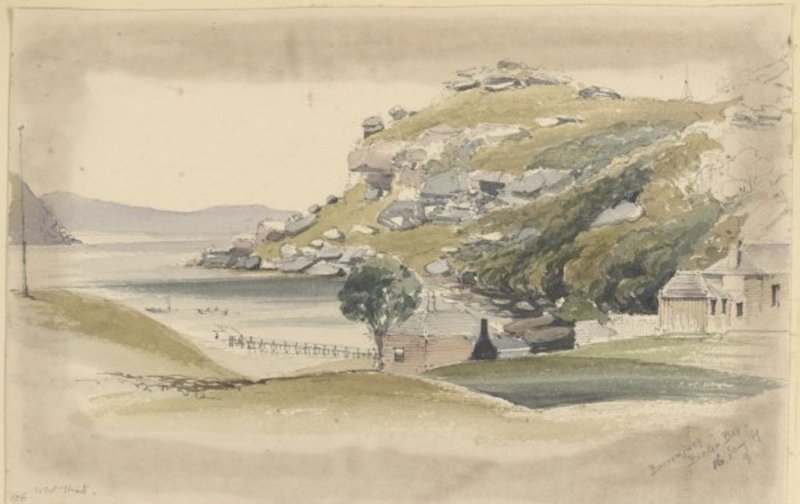
Barrenjuey [i.e. Barrenjoey], Broken Bay 1869 Jan. 16 by George Penkivil Slade. nla.pic-an6454687, courtesy National Library of Australia.
All of their children, John Henry, Ada Louise Ethel, Albert Thomas, Reginald Austin William, Mabel Daisy and Norman Bertie, were born at Barrenjoey, one of whom (Albert T Jnr.), Mr. Sparks book records, was the first to be christened at the newly opened St John the Baptist Church in Pittwater in 1871:
BLACK—January 3rd, at the Customs Station, Broken Bay, the wife of Albert T. Black, of a son. Family Notices. (1869, January 29). The Sydney Morning Herald (NSW : 1842 - 1954), p. 8. Retrieved from http://nla.gov.au/nla.news-article13180619
BLACK—November 27, at Barrenjoey, Broken Bay, the wife of Albert T. Black, of a daughter. Family Notices. (1870, December 2). The Sydney Morning Herald (NSW : 1842 - 1954), p. 8. Retrieved from http://nla.gov.au/nla.news-article13214188
BLACK—January 16, at Barrenjoey, Mrs. Albert T. Black, of a son. Family Notices. (1874, February 13). The Sydney Morning Herald (NSW : 1842 - 1954), p. 8. Retrieved from http://nla.gov.au/nla.news-article13331540
BLACK—June 24, Broken Bay, Mrs. A. T. Black, of a daughter. Family Notices. (1875, July 9). The Sydney Morning Herald(NSW : 1842 - 1954), p. 8. Retrieved from http://nla.gov.au/nla.news-article13356799
It was also quite soon after his appointment that he became Postmaster at Barrenjoey in May of 1871, in part due to a requirement to report on vessels both for Customs purposes and for safety reasons, to monitor what was coming and going:
TELEGRAMS. Colonial & Intercolonial Messages. BARRENJUEE. Saturday. The tug Challenge, with a brig in tow, light in ballast, tried to make Broken Bay this afternoon, but, not succeeding, the brig anchored off Cape Three Points, and at 5 p.m. was still at anchor, having fore and main stay sails set; but she seemed to be drifting fast to leeward. Wind, S. to S.S.W., blowing a gale, with rain, and the sea rising fast. The tug put into Broken Bay. The following small traders put in to-day for shelter :-Star of Peace, Prince Alfred, and Eliza. A fresh breeze was running strongly out of the Hawkesbury. Tuesday. The steamer Pelican, from Brisbane Water to Sydney, sprang a leak, about 4 p.m., off the entrance to Broken Bay. She was at once headed for Pitt Water and beached near the Customs station. It is supposed the injury is only trifling, and can be readily repaired. TELEGRAMS. Colonial & Intercolonial Messages. (1876, July 29). Australian Town and Country Journal (NSW : 1870 - 1907), p. 6. Retrieved from http://nla.gov.au/nla.news-article70602959
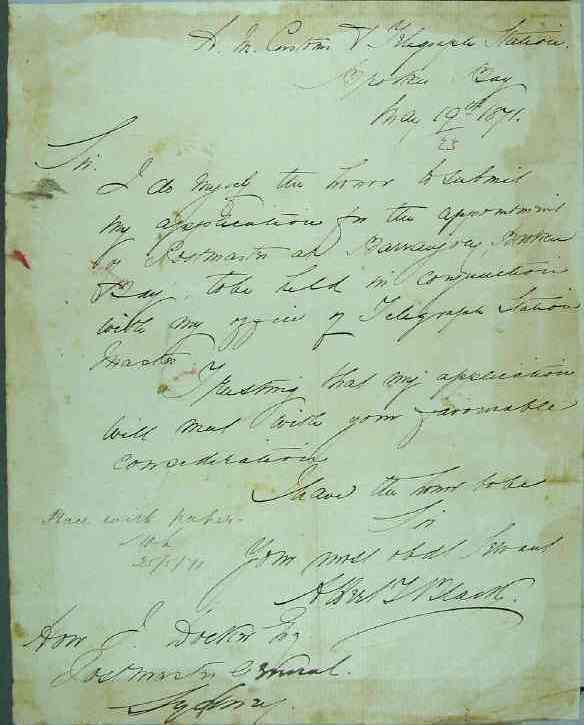
And was appointed August 4th, 1871:
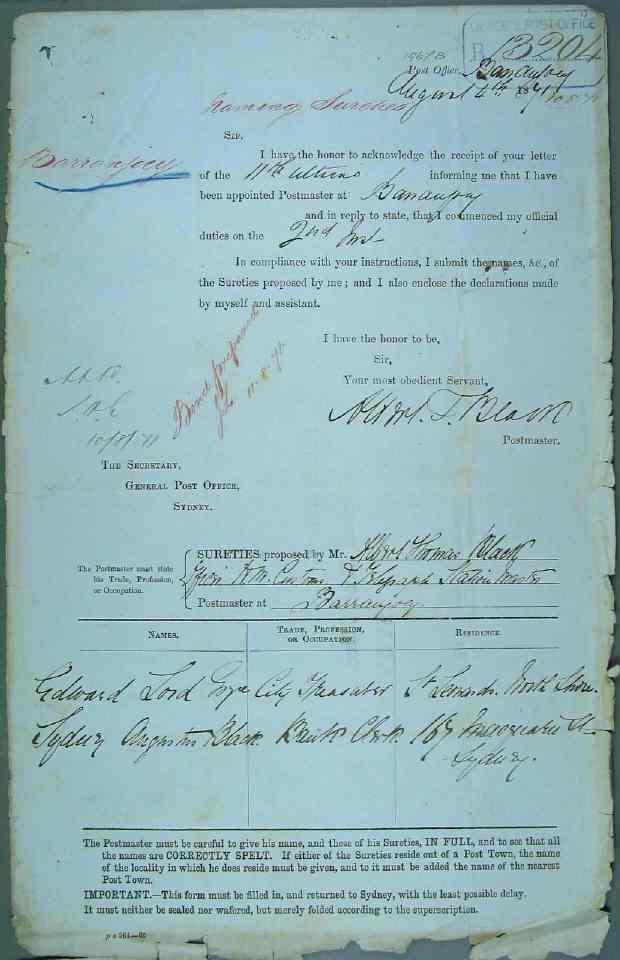
This was the first of many extra duties he would take on:
Government Gazette. FRIDAY, AUGUST 9. APPOINTMENTS,-Mr. A. T. Black, Customs Officer at Broken Bay to act as Inspector of Distilleries for the district of Brisbane Water; Government Gazette. (1878, August 17). Australian Town and Country Journal (NSW : 1870 - 1907), p. 41. Retrieved from http://nla.gov.au/nla.news-article70594021
APPOINTMENTS.-Mr. Albert Thomas Black, Officer of the Customs at Broken Bay, to be an Acting Assistant Inspector of Fisheries GOVERNMENT GAZETTE. (1883, July 4). The Sydney Morning Herald (NSW : 1842 - 1954), p. 5. Retrieved from http://nla.gov.au/nla.news-article28375709
Broken Bay was proclaimed a port in 1871 due to the high volume of boats travelling up and down the Hawkesbury with produce and people. Mr. A T Black had the extra duty of Port Master added to his duties. He and his men were also the savers of lives and those who must house and then return the remains of those lost as well. The amount of wrecks and fatalities during his tenure would have aged even a strong man. A few samples:
FATAL OCCURRENCE AT BARRANJUIE, BROKEN BAY.
ON Boxing-day, Mr. George Smith, J.P., of Manly, held at Barranjuie a magisterial enquiry into the cause of death of a man named Henry Tucker. The following evidence was taken :-
Francis Smith deposed that he was a gentle-man living at Balmain; on the morning of Saturday, the 23rd instant, he started from his wharf in company of John Walker, George Williams, and deceased Henry Tucker, in an open sailing-boat of about three tons, the ketch Ada to proceed to Broken Bay on a pleasure; trip ; a southerly wind was blowing at the time, which fell light after they-got outside the Sydney Heads ; about 12 o'clock the wind came round to the north-east, so they tacked about till about 6 p.m., when he found himself about two miles to the north of Long Reef, and about eight miles from the land; witness then started their course for the North Head of Broken Bay, which he passed at a distance of about two miles; the breeze freshening, and night coming on, he ordered a sharp look-out to be kept for the lights on Barranjuie, which were not visible; the time, as nearly as he could calculate, was then about 7 o'clock; it having set in night they continued a northerly course, deciding upon making the nearest place for shelter; upon daylight appearing this proved to be a bay called Boat Harbour, about one mile south of Barrenjuie; when witness saw the light-house and flagstaff in the morning, he made sail for Broken Bay with a E.N.E. wind blowing ; he rounded Barranjuie Point about half-past 8 o'clock on Sunday morning, and anchored under the inner light-house; he remained for some time fishing, and then made for the inner (western)point of Barranjuie and anchored again ; the wind shortly afterwards freshened ; he rode the breeze out in this spot until he saw indications of a southerly wind, when he attempted to take up a safer position; he made sail, and began to tack up the bay, when 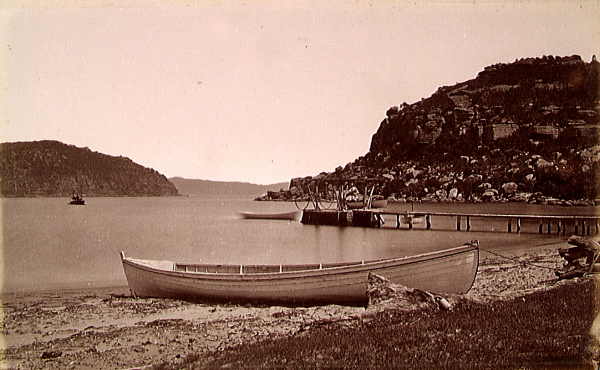 their small boat at the stern broke away: he attempted to wear his own boat round to recover the small one, when she jibed and took in a considerable quantity of water; he then tried to run under the lee of the land, but before reaching it she gradually sank; witness made for the shore with George Williams, deceased and John Walker still clinging to some portion of the seats; after being in the water some twenty minutes, witness was picked up much exhausted by the captain and crew of the Weat Hartley No. 2 schooner and taken to the residence of Mr. A. T. Black, Collector of Customs, where, after much attention, he gradually recovered; he saw the body of deceased brought into the same room as himself, where every means were used to restore animation, but without success ; had he seen the lights on Barranjuie, his intention was to have entered the heads that night and made for the basin; had these lamps been alight he was sufficiently off the land not to shut them out from view, and he believed that the sad occurrence would have been avoided; deceased had been in his employ for about five months, and was a sober, steady man.
their small boat at the stern broke away: he attempted to wear his own boat round to recover the small one, when she jibed and took in a considerable quantity of water; he then tried to run under the lee of the land, but before reaching it she gradually sank; witness made for the shore with George Williams, deceased and John Walker still clinging to some portion of the seats; after being in the water some twenty minutes, witness was picked up much exhausted by the captain and crew of the Weat Hartley No. 2 schooner and taken to the residence of Mr. A. T. Black, Collector of Customs, where, after much attention, he gradually recovered; he saw the body of deceased brought into the same room as himself, where every means were used to restore animation, but without success ; had he seen the lights on Barranjuie, his intention was to have entered the heads that night and made for the basin; had these lamps been alight he was sufficiently off the land not to shut them out from view, and he believed that the sad occurrence would have been avoided; deceased had been in his employ for about five months, and was a sober, steady man.
George Williams, residing at Richmond Villa, Domain, gave corroborative evidence ; had they seen the lights, their intention was to have gone into the bay, but not seeing them they stood in for the land as it was getting dark; witness was picked up, after the occurrence by Mr. A. T. Black, as was also deceased, who appeared to be dead. John Walker also gave corroborative testimony; he stated that on the boat setting down, deceased and witness went into the water together but seeing him paralysed, with fear, witness tried to encourage him by placing a piece of wood under his arms and cheering him up; he kept calling out for help, which further exhausted him, so that on assistance reaching them he believed life to be almost extinct; at the Custom House everything was done to restore animation.
Albert Thomas Black, Collector of Customs at Barranjuie, deposed to starting with his crew to the rescue of some men in a boat which he heard had upset; he rescued George Williams, John Walker, and deceased (whom he believed to be dead),and seeing that a boat was making for Francis Smith, and considering him safe to be picked up, he made for home; he tried for a couple of hours to restore life in Tucker, but failed; he desired to mention the heroic conduct of a lad named Jeremiah Connolly, who, of his own accord, put off in a small boat to save these drowning men. John Connolly, one of Mr. Black's crew, gave evidence as to the up-setting of the boat, which he witnessed from the shore. From the evidence adduced, Mr, Smith, gave it as his opinion that death had resulted from drowning. FATAL OCCURRENCE AT BARRANJUIE, BROKEN BAY. (1871, December 29). The Sydney Morning Herald (NSW : 1842 - 1954), p. 9. Retrieved April 7, 2013, from http://nla.gov.au/nla.news-article13250096
Albert Thomas Black, courtesy John Black, great grandson of A T Black.
THE LATE FATAL ACCIDENT IN BROKEN BAY
To ALBERT T. BLACK, Esq., Customs House Officer, Barranjuie.
Sir,- We hasten to avail ourselves of the first opportunity since our arrival in Sydney, publicly to return you and your courageous crew our sincere and heartfelt thanks for having, with the assistance of the Almighty, been the means of rescuing us from a watery grave on the above occasion. The fact of your having lowered and manned your boat and pulled a distance of over a mile in an almost incredibly short time during a gale of wind, and in a boisterous sea, reflects the greatest credit on you all – one minute's delay would have caused a further loss of life. Your courage was scarcely exceeded by your kindness in the careful attention bestowed by yourself and family onus when carried in an exhausted and almost dying state into your house, where our wants were carefully supplied, and all seemed to vie with each other in doing the utmost in their power to add to our comforts. Your sympathy and untiring exertions to restore animation to our unfortunate companion, although without success, deserve more praise than we can find words to convey, and reflect credit upon the Government for having men like yourselves in the service, who show by their actions that they are willing and prepared to risk their own lives to save their fellow -creatures. In conclusion we trust that your life may be long spared to your wife and family ; and we feel convinced that should a boat accident occur in Broken Bay whilst you are there life will not be lost, if in the power of man to save it. Having remained under your hospitable roof for nearly three days, we bid you a hearty farewell, and assure you that the name of Albert Thomas Black shall be engraven on our hearts as long as it pleases God to spare us.
We further desire to express our admiration of the heroic conduct of Master JEREMIAH CONNELLY, who nobly ventured out in a small boat with the object of rendering assistance, thereby showing his willingness, and incurring a great risk, to save life, if possible.
P.S.-We enclose a small remittance, which please divide among your crew as you think fit. '
Signed, FRANCIS SMITH, Peacock Point, Balmain. J. C. WALKER, Balmain. GEORGE A. WILLIAMS, Richmond Villa, Domain. THE LATE FATAL ACCIDENT IN BROKEN BAY. (1871, December 29). The Sydney Morning Herald (NSW : 1842 - 1954), p. 10. Retrieved from http://nla.gov.au/nla.news-article13249989
CORONER'S COURT, THIS DAY
Captain Melville of the Schooner Caledonia
An inquest was held this morning, before the City Coroner, at the Lord Clyde Hotel, Pyrmont, on the body of Donald McLennan, alias Melville, who was drowned off Broken Bay on Friday last, through the capsizing of the schooner Caledonia, of which vessel he was the master. The body was brought to Sydney, yesterday, by the steamship Diamantina.
Isabella McLennan: I reside at Point-Street, Pyrmont, and recognise the dead body just viewed at my residence, as that of my late husband, Donald McLennan. This name was his proper one; but he was generally known by the name of Donald Melville. He was fifty seven years of age, a native of Scotland, and a master mariner. He commanded the schooner Caledonia, which traded between Sydney and Port Stephens. On Wednesday night last, at about 9 o'clock, he left, home with the intention of going to sea. I saw no more of him till his dead body was brought home, yesterday, by constable Martin. Deceased has been in the colony about twenty-two years. We have been married sixteen years, and have one child. He (deceased) was a man of temperate habits, and has commanded the Caledonia for about five years. Peter Barry deposed: I am a mariner, and have been employed for the last three years as mate on board the schooner Caledonia. I recognise the dead body Just viewed by me as that of Captain Donald Melville, who was master of the schooner Caledonia. On last Friday morning we left Sydney, in ballast, bound for Port Stephens. There was about five tons of cargo on board. The crew consisted of the master, myself, and two other men. The tonnage of the vessel, which was a fore and aft schooner, was between 43 and 50 tons. Before we reached Broken Bay the weather was thick, squally, and rainy, and the deceased determined to run into Broken Bay for shelter. Between Barrenjoey light and the Custom-house station we had very little wind, being under the lee of the land. We were then close-hauled on the port tack, and we passed the Customs' station. The wind was then W.S.W., and the time about half past 11 a.m. While on the port tack, and reaching over for Soldiers' Creek, for anchorage, we attempted to put the vessel about on the other tack, when she was struck by a squall which split the inner jib and fore trysail - though the sails were in good condition. We then dropped anchor in about four fathoms of water. The anchor held on by very little chain. At this time the only sails set were the foresail and mainsail. Deceased, not thinking the position of the ship safe, (it being close to some rocks, and exposed to the squalls) directed the men to heave to the anchor short. I and the two other men went to the windlass to heave up the anchor; deceased, remaining at the tiller. After heaving short, the forestay sail and outer jib were set. The captain was still aft, and it was blowing strong in heavy puffs, with constant rain. I and the two men manned the windlass to heave the anchor, and had scarcely got it tripped from the bottom, when a squall struck the schooner (the wind being then about south) on the broadside. The vessel heeled over to port, and the anchor chains 'fetched over' to the same side. The vessel then went right over, turning bottom up. There were no reefs in the sails previous to this occurrence. I saw nothing more of deceased after the squall which struck the vessel till I saw him swimming, as I thought, for the shore. Two of us, the two seamen and myself, got on the vessel's side, and the other on the bottom, where we remained till we were taken off by a boat belong to another vessel lying in the bay. It was about forty or fifty yards from the shore where the vessel capsized. The body of deceased was recovered in about half an hour after the occurrence. He was quite dead. We never went to sea with more ballast (12.tons) than we had this voyage. The deceased and all hands were sober at the time of the occurrence. Charles Blatt, seaman, of the Caledonia on her last voyage, corroborated the evidence of the previous witnesses. The jury returned n verdict of accidental drowning in consequence of the capsizing of the schooner Caledonia. CORONER'S COURT, THIS DAY. (1872, October 7). Evening News (Sydney, NSW : 1869 - 1931), , p. 3. Retrieved from http://nla.gov.au/nla.news-article114733985
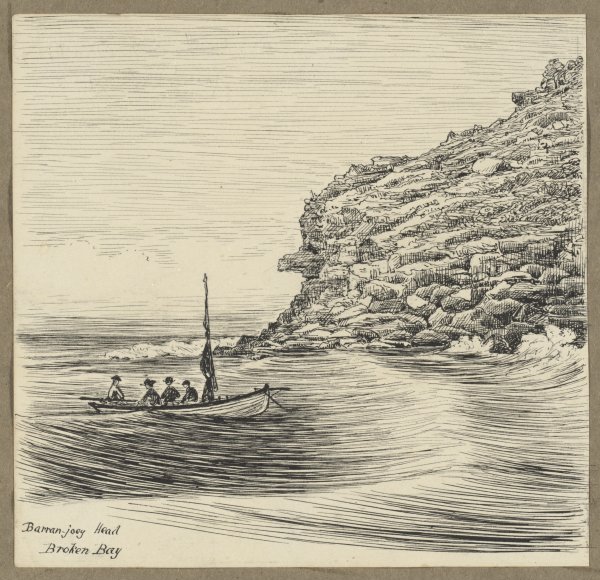 Right: Barranjoey Head, Broken Bay [1884?] nla.pic-an6438965 by Graham, H. J. (Harold John), 1858-1929. Courtesy National Library of Australia
Right: Barranjoey Head, Broken Bay [1884?] nla.pic-an6438965 by Graham, H. J. (Harold John), 1858-1929. Courtesy National Library of Australia
The head, neck, shoulder, arm, and other portions of the remains of apparently a youth about 17, were found recently in the stomach of a shark caught at Barrenjoey, New South Wales. The remains are believed to be those of the cabin boy drowned in the collision of the Barrabool and the Bonnie Dundee. The Sydney Marine Board have concluded the inquiry in the late collision case of the Barrabool and the Bonnie Dundee. They exonerated the captain of the Bonnie Dundee, and adjudged the mate in default. The latter had his certificate suspended for twelve months. Facts V Scraps. (1879, April 12). The Australasian Sketcher with Pen and Pencil (Melbourne, Vic. : 1873 - 1889), p. 11. Retrieved from http://nla.gov.au/nla.news-article60623206
The isolated position of Barranjoey and being 'on station' clearly at times caused strain for his assigned men:
THE CASES OF W. J. STEERE AND J. QUINN.-Two petitions were lately presented to the Legislative Assembly of a somewhat remarkable character, by two men employed in the Customs' boat at Broken Bay. The accusations and other statements are nearly in the same language, and are as follows, as given by Quinn in his petition:-
" On the 18th day of January, 1871, while on duty in the Broken Bay Customs' boat, on our way from Gosford to the station, your petitioner was unlawfully assaulted and forced down in the boat by Michael Madden and John Conolly, boatmen. The officer (Mr. A. T. Black) and those men were in a state of drunkenness. Madden was like a madman ; he held a stretcher in his hand, as if about to strike me with it, accompanying it with a threat that he would knock my brains out, to that I considered my life to be in danger, and was compelled to jump overboard to save it. Your petitioner attributes the saving of his life to Mr. H. P. Palser, J,P., C. E. Jeannerette, manager of the Parramatta Steam Company, and Mr. Rock Davies, master-shipwright, of Brisbane Water, for they took all the stretchers they could got hold of, and threw them overboard, to prevent their being used about some one's head, and one of them assisted W. J. Steere (boatman) to pull the boat into shallow water.
After I left the boat, Madden assaulted Steere, and to prevent being struck by Madden with the stretcher he (Steere) had to jump overboard. Messrs. H. P. Palser, C. E. Jeannerette, and R. Davies left, thinking it unsafe to go any further in the boat ; we had to wade over a hundred yards to get to the shore, through the water, and we left the other two boatmen (Connelly and Madden) and Mr. Black, the officer, quarrelling and fighting among themselves in the boat. Your petitioner and the above named gentlemen, and W. J. Steere, boatman, walked to Mr. Davies's place, and Mr. Davies kindly lent your petitioner and Steere a small boat, and we started for the station ; and we had to go across Brisbane Bar in this small boat, and arrived there about half-past 9 o'clock the same night. Your petitioner was discharged on the 9th day of February,1872, without any fault of his own ; and the case having been taken out of the Collector's hand your petitioner could not get an investigation into his case." ADELAIDE. (1873, February 28). The Sydney Morning Herald(NSW : 1842 - 1954), p. 5. Retrieved fromhttp://nla.gov.au/nla.news-article13320475
TO THE EDITOR OF THE HERALD.
Sir,-A paragraph appears in your issue of 28th ultimo, containing the substances of petitions lately presented to the Assembly by two men formerly in the Government service, Customs branch, Broken Bay. As the petition contains statements which reflect upon my character, not only privately, but as a Government official, I beg that you will give insertion to this letter, in which I emphatically and distinctly deny the statements contained in the petitions. These misrepresentations, to call them by no other name, made by these men, were investigated sixteen months ago, and I was honourably exonerated from all blame by the Government. ALBERT T. BLACK. H. M. Customs, Broken Bay, March 10, 1873. TO THE EDITOR OF THE HERALD. (1873, March 13). The Sydney Morning Herald (NSW : 1842 - 1954), p. 3. Retrieved from http://nla.gov.au/nla.news-article13308942
Mr. Charles Jeannerette would not have testified against Mr Black as it was Mr. Black who recommended that he (Jeannerette) be awarded the mail contract at this time (for steamers), which he duly was.
The two, from reports given, appear to be the best of friends and entertaining the official party at the laying of the foundations for the lighthouse, all of which he would have witnessed being built:
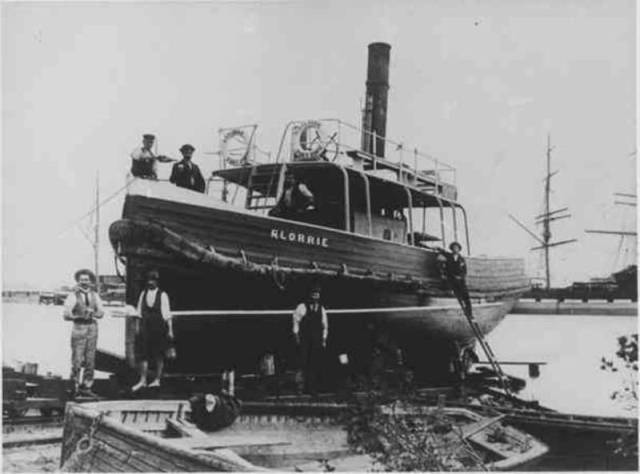 But our steamer, the good ship Florrie, owned by Mr.Jeannerett, is in waiting, lying alongside a jetty at the head of the bay, so we immediately embarked for our destination, Barrenjoey, a distance of about eight miles. On the opposite side of the bay is New Port, the property of Messrs. Mills and Pile and Mr. Jeannerett, who are erecting an hotel, for the accommodation of visitors to the bay. It will have a fine situation and when the place becomes more widely known, as it deserves to be, the hotel will doubtless be largely availed of. The trip down the bay was greatly enjoyed and every point of interest critically scanned. Shortly before 1 o'clock, or about an hour after leaving the wharf, we steamed opposite the jetty at the Customs-house landing, a short distance away-the depth of water not permitting us to go alongside, and soon Mr. Black, with his whaleboat, came along-side. The whole of the party were then transferred to her, and safely taken on shore, while the provisions, ice., were conveyed in another boat.
But our steamer, the good ship Florrie, owned by Mr.Jeannerett, is in waiting, lying alongside a jetty at the head of the bay, so we immediately embarked for our destination, Barrenjoey, a distance of about eight miles. On the opposite side of the bay is New Port, the property of Messrs. Mills and Pile and Mr. Jeannerett, who are erecting an hotel, for the accommodation of visitors to the bay. It will have a fine situation and when the place becomes more widely known, as it deserves to be, the hotel will doubtless be largely availed of. The trip down the bay was greatly enjoyed and every point of interest critically scanned. Shortly before 1 o'clock, or about an hour after leaving the wharf, we steamed opposite the jetty at the Customs-house landing, a short distance away-the depth of water not permitting us to go alongside, and soon Mr. Black, with his whaleboat, came along-side. The whole of the party were then transferred to her, and safely taken on shore, while the provisions, ice., were conveyed in another boat.
The arrangements-for carrying on the works seem to meet all the requirements. Houses for the accommodation of the workmen have been erected on the seaward side of the isthmus which joins Barrenjoey to the mainland, and the men seem comfortable and contented. At half-past 4 the steamer arrived, and after good-byes had been exchanged, the party were soon taken on board by the whaleboat, and a start made for home. An hour’s steaming brought us alongside the wharf which we had left in the morning, where the vehicles were found drawn up in readiness. Alter a little time they were filled, and the land journey was proceeded with.
Nothing of moment occurred on the way; the dreaded Narrabeen was crossed in safety, and the party put down in safety at Host Cohon's Hotel, Manly, where a cup of tea was hastily partaken of ;and a move once more made to the wharf. Alter a pleasant trip of a little less than an hour, we were landed at the Circular Quay, having spent a day's unalloyed enjoyment. Everything connected with the trip, from first to last, had been most carefully attended to, and the result was a genuine success. LAYING the FOUNDATION-STONE of a NEW LIGHTHOUSE at BARRENJOEY. (1880, April 17). The Sydney Morning Herald (NSW : 1842 - 1954), p. 7. Retrieved from http://nla.gov.au/nla.news-article13458288
Or Mr Black joining Jeanerette when he hosted other dignitaries in trips up the Hawkesbury river:
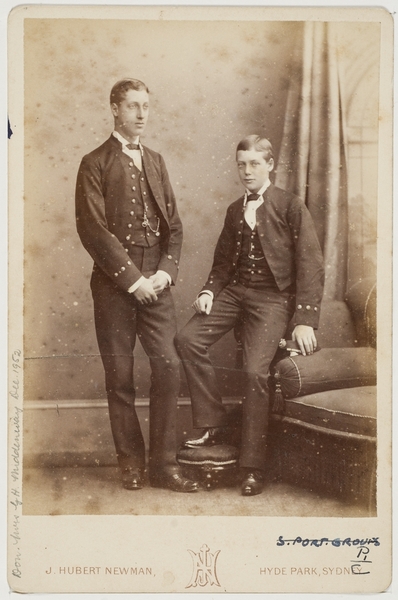 Yesterday morning a party from Government House and the detached Squadron made an excursion up the Hawkesbury, and for-tunately the weather was so fine that every lovely scene on the river appeared to the best advantage. The Royal Princes were of the party. At an early hour those engaging in the excursion left Man-of-war Stairs, and proceeded in the steam launch Nea to Manly, whence they were conveyed by Mr. Boulton's coaches to Newport. There they were received by Mr. Jeannerett on board the steam launch Pelican. Barrenjuey was passed about 11 o'clock. At Barrenjuey Mr. A. T.Black and friends were invited on board the Pelican, and the boat then proceeded up the river. The Detached Squadron. (1881, August 4). The Maitland Mercury and Hunter River General Advertiser (NSW : 1843 - 1893), p. 6. Retrieved fromhttp://nla.gov.au/nla.news-article819027
Yesterday morning a party from Government House and the detached Squadron made an excursion up the Hawkesbury, and for-tunately the weather was so fine that every lovely scene on the river appeared to the best advantage. The Royal Princes were of the party. At an early hour those engaging in the excursion left Man-of-war Stairs, and proceeded in the steam launch Nea to Manly, whence they were conveyed by Mr. Boulton's coaches to Newport. There they were received by Mr. Jeannerett on board the steam launch Pelican. Barrenjuey was passed about 11 o'clock. At Barrenjuey Mr. A. T.Black and friends were invited on board the Pelican, and the boat then proceeded up the river. The Detached Squadron. (1881, August 4). The Maitland Mercury and Hunter River General Advertiser (NSW : 1843 - 1893), p. 6. Retrieved fromhttp://nla.gov.au/nla.news-article819027
Many owners of fine vessels that would visit Pittwater or travel up the Pittwater are recorded as having stopped at the Customs Station to try and entice Mr. Black to join them - he was very popular, known for his acumen, integrity and a penchant for finding the best oysters.
He owned land at Church Point, and at Careel Bay, which was divided between his children under the terms of his will - his unmarried daughters inheriting the lions' share of property - possibly to offset the 'more work for less money' wage gap that existed even then in Australian society.
He was also one of many local settlers plagued by the Farrell's:
IMPORTANT TO STOCKOWNERS. — A case of some interest to stockowners, which serves to show how far the cattle-stealing prevention act goes in protecting their rights, recently came before the water police court, Sydney. Under the third section of that act, John Farrell, licensee of the Colonnade Hotel, Manly Beach, was summoned by Thomas Albert Black, customs officer at Barrenjoey, with having illegally used a certain Devon bull between the 8th and 22nd days of September last. The case against the defendant was that he was seen driving the bull away from its pasture grounds together with two cows, and that subsequently the animal was seen in a securely-fenced paddock belonging to Farrell, at his farm, two miles distant, herding with some cows.
The defence was that the bull had trespassed if it had been in the paddock, as it was very clever at getting over fences or through them, if they were at all out of repair. On defendant's behalf, it was denied that he had ever driven the bull home as alleged, and that even if he had done so he did not intend to illegally use it, as the animal was valueless at the stud. For complainant, Mr. W. Roberts sen., (who with Messrs. Merriman and Carroll were retained to prosecute), urged that the case was a gross one, and that it behoved the magistrates to use their authority to protect the stock of settlers in isolated places by sending defendant to gaol under the penal provisions of the clause, which gave their worships power to inflict a sentence of twelve months' imprisonment, or a fine of £20.
The magistrates held the case proved, and fined Farrell £10, with £3 3/- professional costs, to be levied by distress in default of payment, failing which two months' imprisonment. He was defended by Messrs. Clayton and Lowe, who asked the court to allow the costs to be paid out of the fine, but the request was refused. ST. SAVIOUR'S DAY-SCHOOL. (1881, January 19). The Goulburn Herald and Chronicle (NSW : 1864 - 1881), p. 2. Retrieved from http://nla.gov.au/nla.news-article103812500
Another description of the Customs station and Mr. Black's duties
Peate's Ferry and Part of the Hawkesbury. By "NOMAD."
Peate's Ferry is called Peate's Ferry because a party by the name of Peate used to ferry people across the Hawkesbury in the days when the Hawkesbury was the Hawkesbury before Sydney was born, to quote the Welsh, which is satisfactory nomenclature. A man once told me, on inquiry, that a piece was called Boolongoo-barribie, because a fight between the natives and the whites occurred there, so it is a comfort to know that we needn't bother much about the way in which Peate's Ferry achieved its designation. Everybody is, of course, acquainted with the configuration of the Australian coast, and it is only necessary for me to mention that on entering Broken Bay one finds three great sheets of diverging waters—the Broadwater ; with its confluents and affluents, at the head of which lies Gosford, to the right ; the Pitt Water ending in Newport on the way to Manly, on the left ; and the Hawkesbury River guarded by the crouching Lion Island straight ahead. Barrenjoey (Barrangewie, the poetic post, and every other thing else master wishes to have it pronounced in spite of the obvious fact that some prosaic old whaler on catching sight of the bald, sterile rock on which the lighthouse stands, sang out " Barren Joey,") is a great place. After leaving the Pacific and rounding the huge rock, one sails into a splendid bay where the jetty stands, where Mr. Black has his house. As I sail before Mr. Black is post and telegraph master, Customs officer for the Hawkesbury River, and holds a number of other offices, and only those who have enjoyed his princely hospitality, can form any idea of his generosity and the beauty of his principality. The settlement consists of Mr. Black's residence, a charmingly embowered dwelling, standing in the midst of a fine garden and grounds, and some few boatmen's cottages by the brown sand and the sea shore. The water is still and exquisitely blue, and the foliage luxuriant and plentiful. Up the Pitt-water there is fine arable land, well treed and grassed, and in time settlement will push over there from Manly. The lighthouse at Barrenjoey is up the hill on the bold promontory, and is quite out of sight; the climb to the edifice and surrounding buildings being tedious and difficult enough to deter the ordinary tourist. Leaving Barrenjoey, we proceed up the Hawkesbury…Peate's Ferry and Part of the Hawkesbury. (1884, August 4). Evening News (Sydney, NSW : 1869 - 1931), , p. 6. Retrieved from http://nla.gov.au/nla.news-article107262718
At only 50 years of age Albert Thomas Black passed away. Some reports state he died at Barrenjoey, others that he passed away at a family residence, or place of rest for those with an illness:
BLACK. —August 22, at 87 Moncur-street, Woollahra, Albert Thomas Black, of Barrenjoey, Broken Bay, aged 50 years. Family Notices. (1890, August 23).The Sydney Morning Herald(NSW : 1842 - 1954), p. 1. Retrieved fromhttp://nla.gov.au/nla.news-article13773459
THE FUNERAL of the late Mr ALBERT THOMAS BLACK, late of Barrenjoey, Broken Bay, will leave 87 Moncur-street Woollahra THIS (Saturday)AFTERNOON, at 3 o clock to family vault Randwick CHARLES KINSELA, .. Oxford street Family Notices. (1890, August 23). The Sydney Morning Herald(NSW : 1842 - 1954), p. 16. Retrieved fromhttp://nla.gov.au/nla.news-article13773466
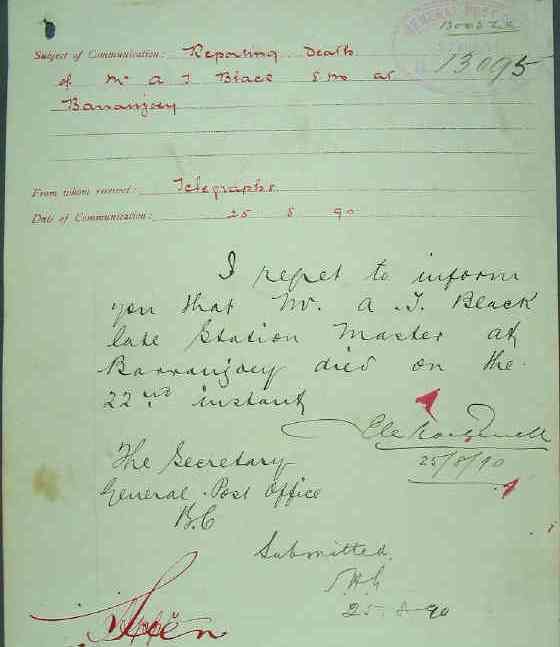
This item states Mr. Black passed away at Barrenjoey, at 8 p.m. on August 22nd, 1890 - from National Archives of Australia Barrenjoey records - archived box of materials
The legacy of Mary Hyde, a lady who could not own property outright due to the laws of her time which discriminated against the fairer sex prior to the Married Women's Property Act 1882 (NSW 1889), did her utmost to look after her daughters. This was a legacy embraced by her son and grandson. Albert did purchase land in Pittwater, at Church Point, and Mabel, whose ashes were scattered over Barrenjoey as she wished when she passed away, and her sister, were the inheritors of this land:
Primary Application - Ada Louisa Ethel Black & Mabel Daisy Black Bay View Road Pittwater Shire Warringah Parish Narrabeen Volume 2284 Folio 1 Date range: 30/08/1911 to 20/08/1912 and Primary Application - Mabel Daisy Black 8 acres 26 perches at Pittwater on Bay View Road & road 50 links wide in Shire Warringah Parish Narrabeen County Cumberland Volume 2524 Folio 81, Date range:24/03/1914 to 17/10/1914
Albert and Kate's sons embarked on adventures of their own which saw some of them travel far and wide:
LIFE IN LAGOS - AN AUSTRALIAN'S EXPERIENCES IN WEST AFRICA. - THE BLACK MAN UNDER BRITISH RULE.
Mr. John H. Black, son of Mr. Albert Black, late of Broken Bay, and nephew of Mr. R. G. Black, M.L.C., who now occupies the position of as general manager of railways in the British colony of Lagos, on the Guinea Coast of Africa, is now on a visit to Australia. Mr. Black is well known in Sydney, as he was connected with the Railway Department in this State for some time, before he went to West Australia, and thence to Africa.
Life on the West Coast of Africa is not the pleasantest, according to Mr Black, but to those in official positions it has compensations in the way of high salaries and extensive leave. The ordinary service appointments are for one year and after the first 12 months six months' leave is granted in each year.
The climate, however, is not good, to put it mildly, and the white man finds it necessary to strongly fortify himself against the maladies of the country with quinine; indeed, but for quinine, says Mr. Black, "it would be Impossible to live there at all." Malaria and black fevers are the prevailing diseases, and Mr, Black has twice fallen a victim to the former complaint The death rate among the white people employed on the railways, with the exception of the officials, has been very high, averaging about one in 10, but among the-officials it has been very low indeed.
Large sums of money are, however, now being expended in lighting the spread of malaria by destroying the mosquito, scientifically proved by Major Boss, of the Tropical School of Medicine, of London, to be the real medium of the spread of the disease.
"Kill the mosquito, and you kill malaria," is the cry of the whites of Lagos, most of whom arc stricken with the fever, and the warfare against the insect is being carried on with so much determination that it is hoped that the risk of attack by disease will be greatly reduced. The atmosphere is so full of moisture during the wet season especially, that all food has to he tinned, or it would not be fit to be eaten…. LIFE IN LAGOS. (1902, June 9). The North Queensland Register (Townsville, Qld. : 1892 - 1905), p. 25. Retrieved from http://nla.gov.au/nla.news-article82350822
The son named for him, like Mabel, kept to the salt waters of Pittwater:
PITTWATER REGATTA. A Varied Programme. The twenty-fourth annual Pittwater regatta will be held on Saturday, when a programme of sailing, rowing, and motor boat events, 2S in all, with a total entry of 177 competitors, will be decided, from 10 a.m. The steamer Gosford will act as flagship, taking up her moorings a Uttle to the south of Salt Pan Point, so that one will be adjacent to the finishing line of all the races. Events and their starting times are:
SAILING. Mrs. E. Q. Grieg handicap, 12ft to 25ft local boats, 10.30 a.m ; 12ft cadet dinghies' champion-ship. 11 a.m.; John Roche all yachts nominated skippers, 11.15 a.m.; Mischief Memorial nominated skippers, 11.40 a.m.; Pittwater Regatta Cup. all yachts, 1.15 p.m.; Scotland Island Trophy. S.AS.Club boats, 2 p.m.; A. T. Black 12ft cadet dinghies'handicap. 2.35 p.m.; John Williams handicap,12ft to 25ft local boats, 2.50 p.m. PITTWATER REGATTA. (1930, December 24). The Sydney Morning Herald (NSW : 1842 - 1954), p. 14. Retrieved from http://nla.gov.au/nla.news-article16741210
And of course, the wonderful John Black, who still is a volunteer of the Chase Alive Program of our National Parks and Wildlife Service and can be found regularly atop the Barrenjoey Headland, still.
____________________________________________
This weekend marks the 17th year of the International Lighthouse and Lightship weekend - while Barrenjoey is open every weekend to visitors - even f the Customs Station and its historic buildings along Station Beach are now long gone.
References:
Sparks, Jervis. 1992. Tales From Barranjoey.
Mary Hyde. (2014, April 12). In Wikipedia, The Free Encyclopedia. Retrieved from http://en.wikipedia.org/w/index.php?title=Mary_Hyde&oldid=603894119
1. John Black (privateer). (2014, February 13). In Wikipedia, The Free Encyclopedia. Retrieved from http://en.wikipedia.org/w/index.php?title=John_Black_(privateer)&oldid=595363712
Albert and Kate Black with their family at Barrenjoey - W. Deaton standing (mid Centre), Kate's sister is lower left - Kate is mid picture -
Below: Station Beach, Barrenjoey (Broken Bay), circa 1879-1889 by Charles Potter(Government Printer); and details from (crops) - Photographs, New South Wales [album of views of Sydney, Blue Mountains and surrounds], ca. 1879 / attributed to N.S.W. Government Printing Office and courtesy State Library of NSW:
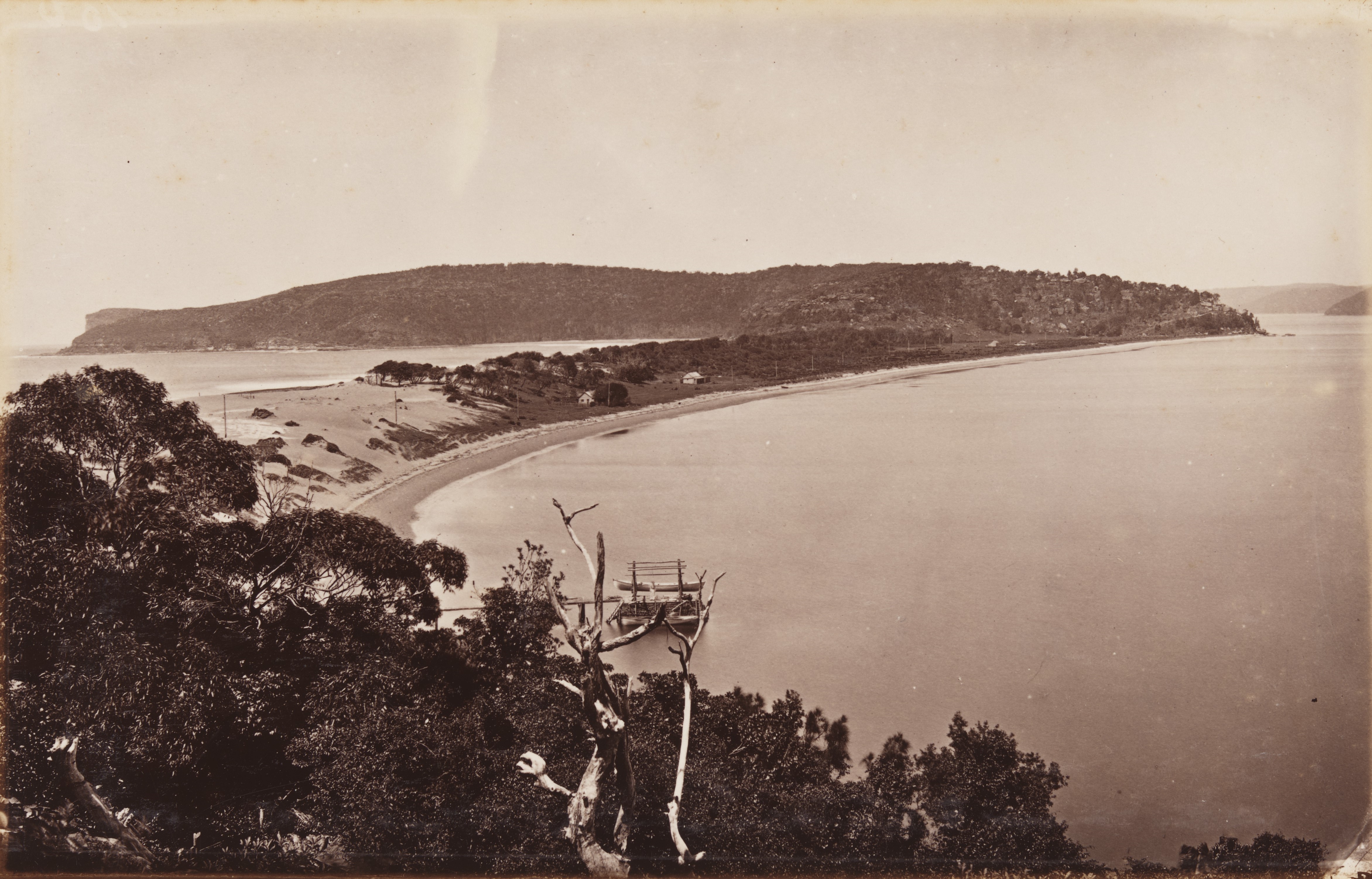
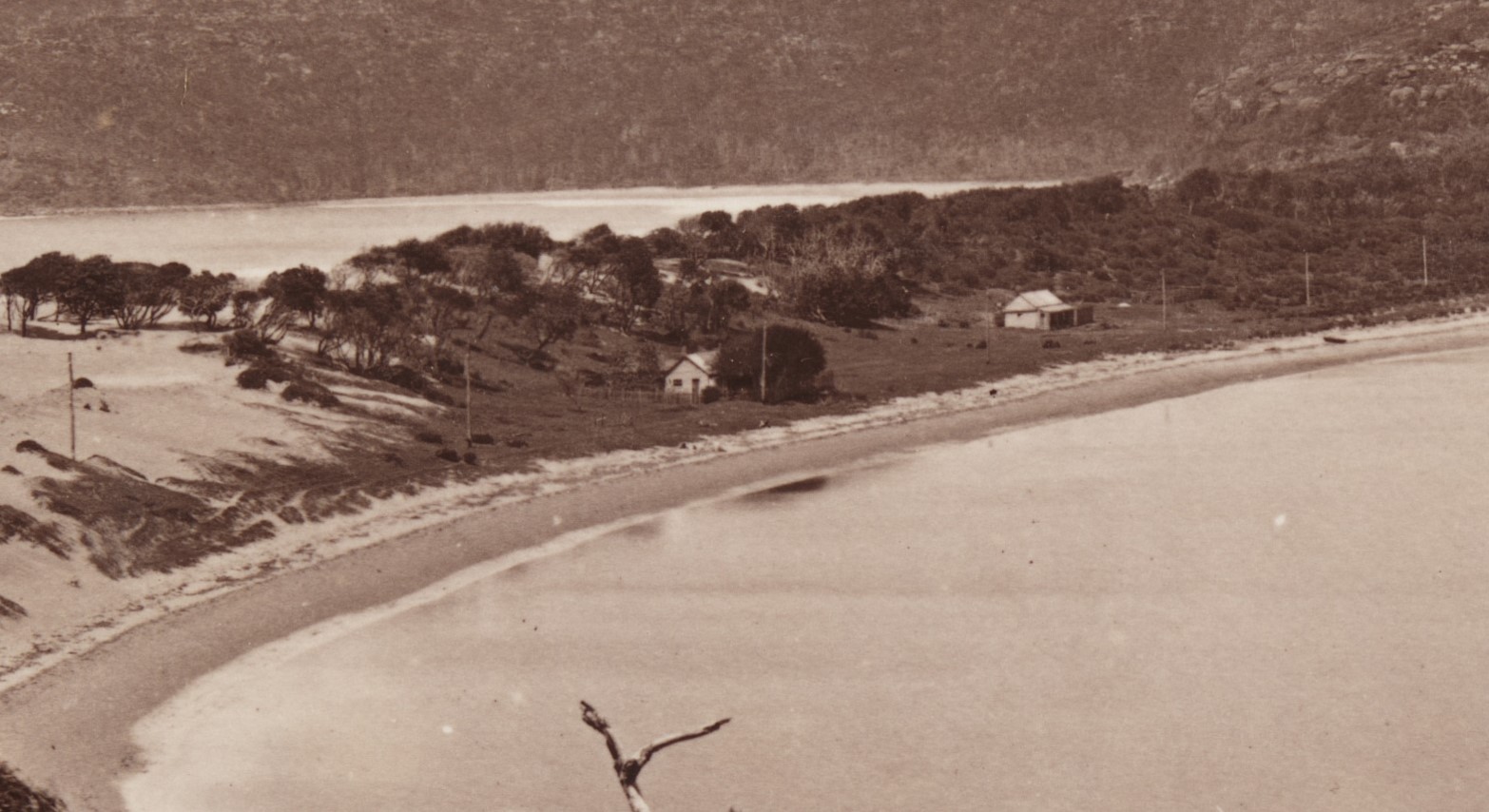
.jpg?timestamp=1707416129938)
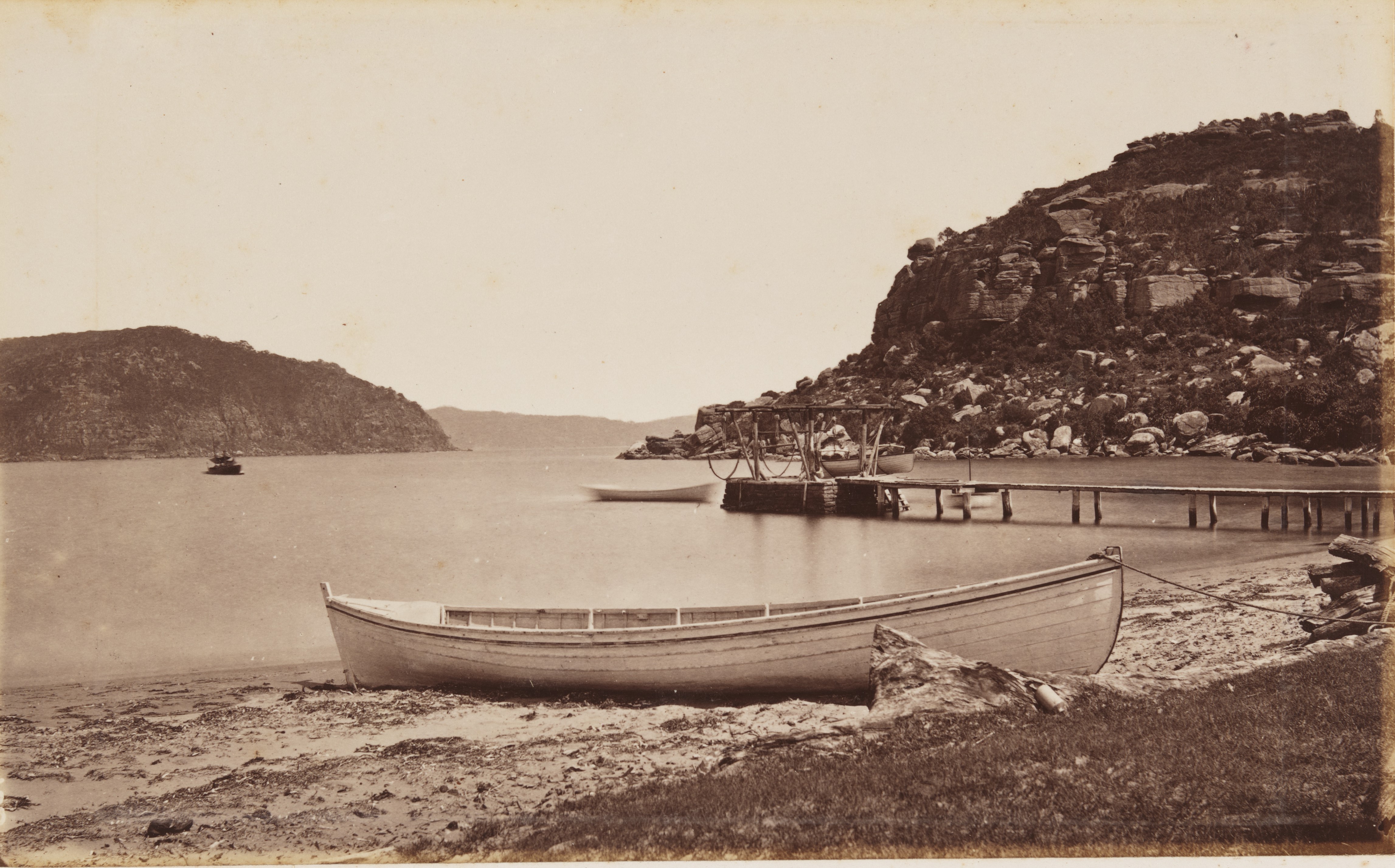
.jpg?timestamp=1707416223245)
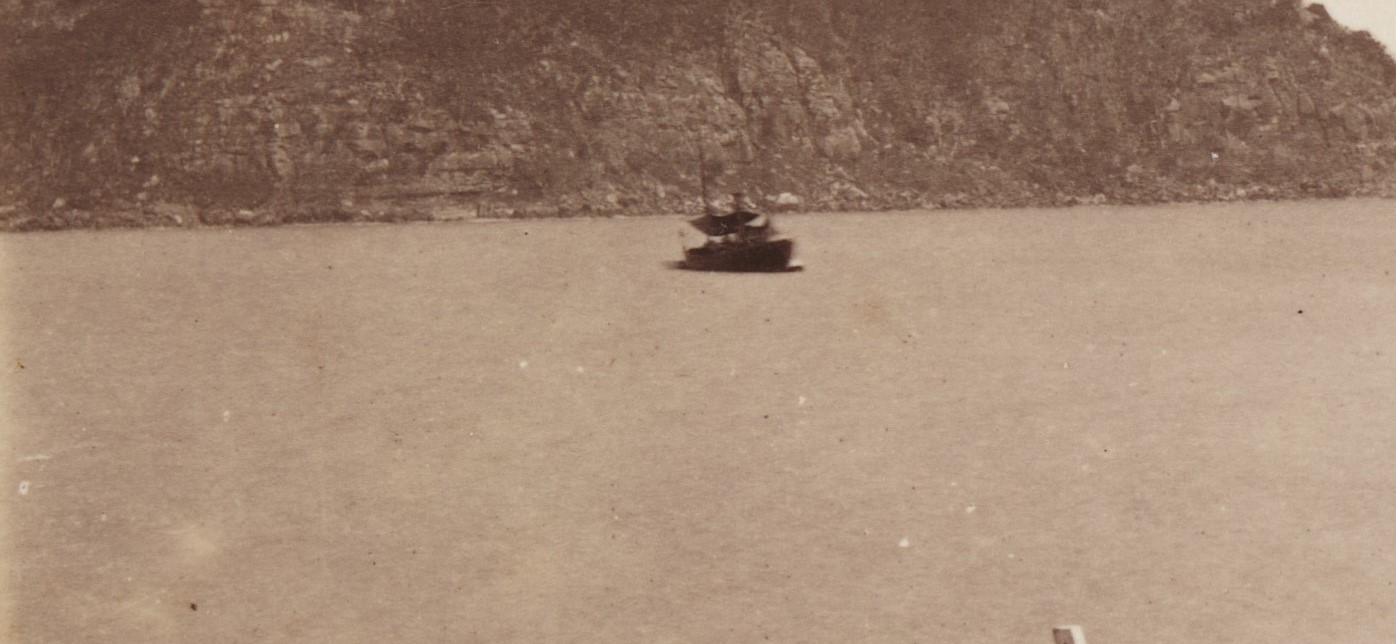
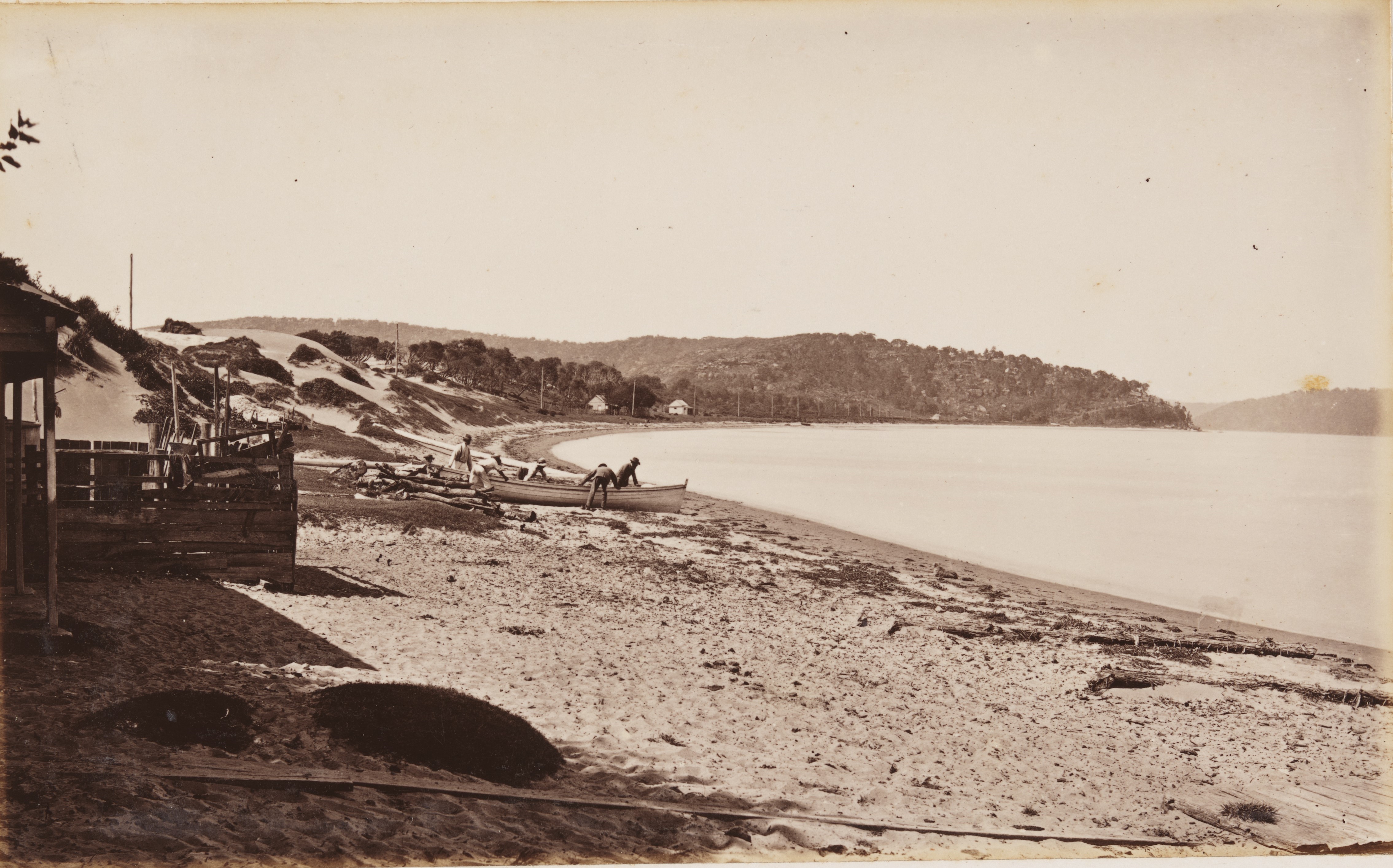
.jpg?timestamp=1707416322130)
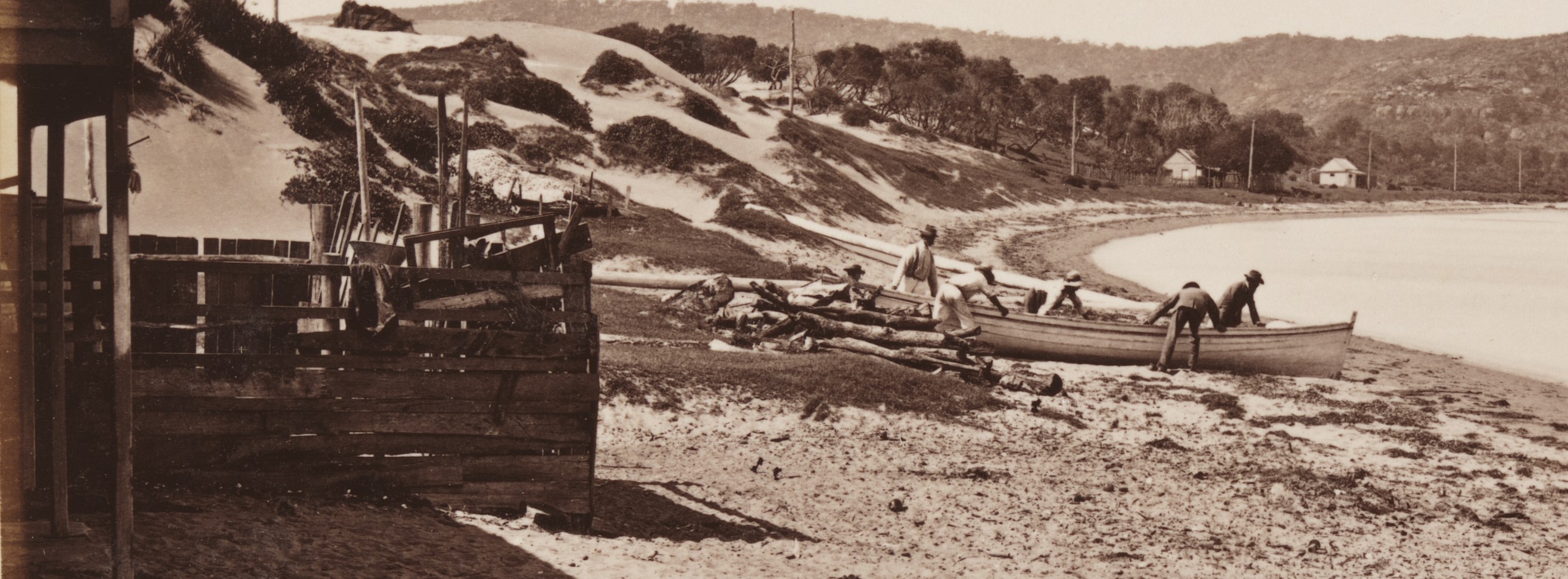
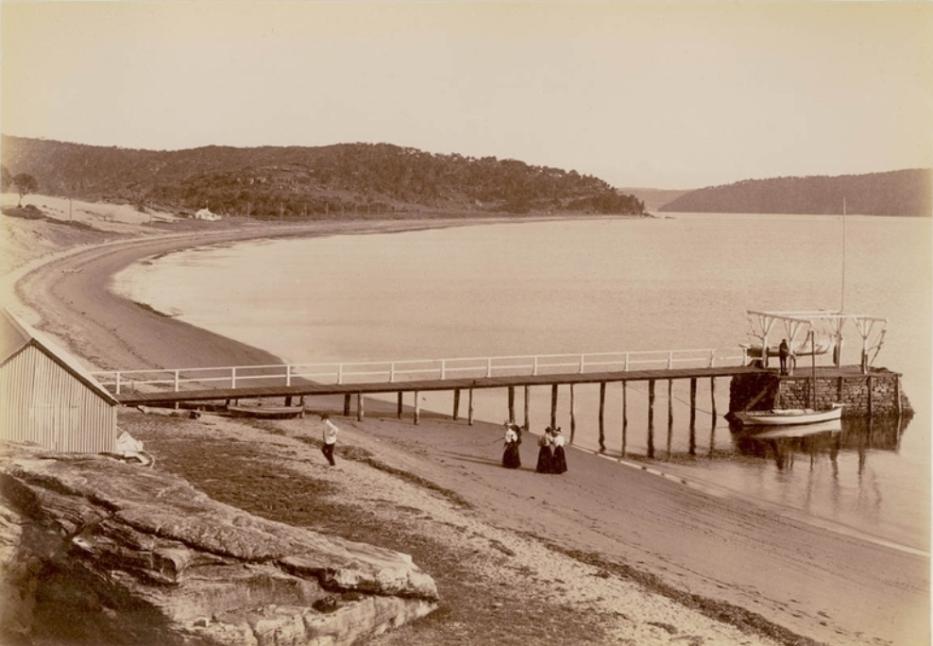
Above: Wharf, Barrenjoey, Hawkesbury River, circa 1900-1910. Pic No: a116421, Courtesy of The State Library of NSW
Albert Thomas Black threads collected and collated by A J Guesdon, 2014.